Dark Floors or Light Floors, Which Is Best For Your Home?
If you want to change the look and feel of your home, where do you start?
While a new couch or even a new shade of paint can make a big difference, the best place to start is with your flooring. Flooring sets the tone for your entire living space. And depending on whether you select dark floors or light floors, it will create a canvas you can continue to play up.
What’s the best choice: dark floors or light floors? Luckily, there isn’t a right answer. No flooring is perfect, each has its pluses and minuses. Only you can decide what’s suitable for your family.
But, if you’re trying to decide between the two, we’re here to help. We can offer some friendly advice, to help you make the best decision for your situation. Start with a few questions:
- What do I prefer, dark or light floors?
- What is the style of my home?
- Do I have a busy household that makes maintenance-free living a necessity?
- Do I have pets that add to the equation?
- How often will I have time to clean?
- How big is my home? How open are my rooms?
- What flooring choice will go best with my decor?
Even with simple questions like these, you might start seeing one choice pull away from the other.
Let’s compare cleaning
Nobody enjoys cleaning – wouldn’t you rather spend time with your family and friends? If that’s the case, there’s a distinct winner in which type of flooring you should choose.
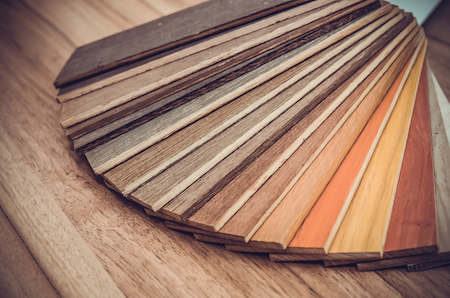 Light floors have a distinct advantage over dark. Light floors show less of the dirt on your floors than dark. If you have a large, messy household, light can help you conceal it longer.
Light floors have a distinct advantage over dark. Light floors show less of the dirt on your floors than dark. If you have a large, messy household, light can help you conceal it longer.
If you still prefer dark floors, consider lightening the shade you choose. Satin finishes are also better known for showcasing dirt on the floor.
Of course, you can always just clean more. Make it a part of the family chores, and buy the appropriate tools so you can make cleaning a snap.
What about scratches?
If you’ve ever had hardwood flooring in your house, you know scratches are unavoidable. Its soft surface means that the more wear, the more you’ll have slight imperfections, dents, and scratches showing through the wood.
Yet dark hardwood tends to show scratches even more. This is because most hardwood species are lighter in color, and stained to achieve the dark wood look. When a scratch is placed on the surface, it takes away the dark pigment, allowing the lighter wood to shine through.
If you want dark floors, understand they will take more maintenance. Instead of pushing out the timeframe to refinish the color, with dark wood, it may need recoating every three to four years.
No matter what color finish you have, you can consider buying a stain marker. They make them in all kinds of colors, and help camouflage the scratch until you can refinish the entire floor. This is an easy way to mask imperfections and keep your floors looking good.
Are dark floors or light floors better for a small home?
In general, dark floors will make any space look a bit smaller, and light floors will make the space a bit bigger. However, there’s more to it than that. Color is often an optical illusion, and you can play with color on both the floors and walls to change the way a room looks and feels.
When you see layouts with dark floors, they tend to showcase well in larger homes or homes with open concept living. If you’re worried about your space being too enclosed, you can change up the look by adding in lighter colored walls, and increase the amount of overhead lighting. Don’t block out the natural light with heavy shades or drapes. Let the natural light flow in.
Let’s talk costs – is one more expensive than the other?
When you’re shopping for new hardwood floors, you’re going to find all colors across the various price points. No matter what color of stain you choose, there’s going to be a product for you to choose from.
That said, you should always focus on quality as it will help with both upkeep and maintenance down the road.
Costs also are determined by whether you install prefinished floors, or will be handling all of the finishing work after installation.
If you’re finishing on site, more natural colors are often easier and will be less expensive to stain. If you have a specific color, are trying to go with a gray or whitewash color, it can take more coats to achieve the desired results. It may also be more expensive for a specific type of polyurethane. Specific flooring often requires different coatings depending on traffic and use. Talk with one of our flooring specialists if you have specific concerns.
How to select the right color you’ll fall in love with
The world is now being driven by technology in every aspect of our daily lives, renovations included. Maybe you’ve found flooring in a magazine you love. Or maybe you’ve pinned a bunch of samples, and one color of flooring keeps surfacing again and again.
Yet when you see it in person, you’re just not sure it’s you.
It’s good to know that what you see in print or online isn’t always the way it appears in person.
It’s okay to like something online, and change your mind on it once you see it in person. Better yet, take a few selections home with you, and lay them out in your room. Which looks better with your design? Which makes you feel happier when you enter the room? Be sure to see it in all lighting conditions, morning, noon, and evening.
Bringing home samples can also help you choose undertones of a particular color. If you have red-toned furniture, it might not look right with yellower hardwood. After setting up one sample near your favorite sofa, you may settle on a color quickly.
And don’t forget, you can further change the impact of a room by adding an area rug. You can bring out the color of the hardwood, and blend it with your furniture.
Which is right for you: dark floors or light floors?
We can help you make a choice, install it, and love it for years.
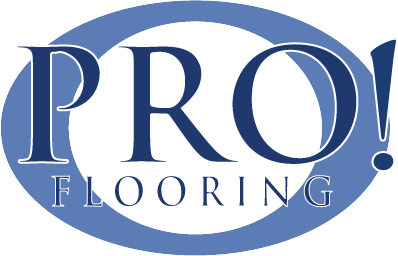
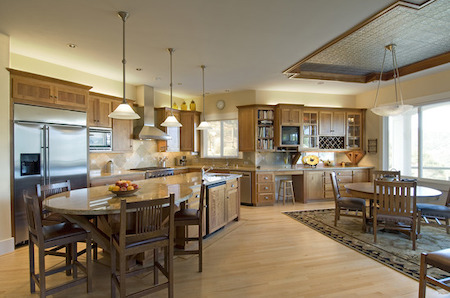 When people decide to install hardwood floors, they focus on the price of the hardwood. But there’s more to it than that. If you get an estimate on how much it will be to add hardwood flooring to different rooms in your home, it will contain several costs.
When people decide to install hardwood floors, they focus on the price of the hardwood. But there’s more to it than that. If you get an estimate on how much it will be to add hardwood flooring to different rooms in your home, it will contain several costs.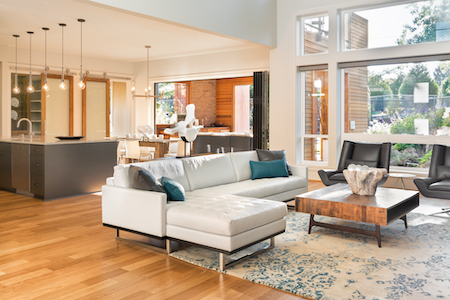 Like sisal, jute is made of natural fibers derived from Jute plants. Jute is grown mainly in Bangladesh and India from a tall, spindly plant that is also used to produce burlap. It comes with a natural light brown hue that can be dyed. But because of the color and texture, the hues will take on a more muted, earthy tone.
Like sisal, jute is made of natural fibers derived from Jute plants. Jute is grown mainly in Bangladesh and India from a tall, spindly plant that is also used to produce burlap. It comes with a natural light brown hue that can be dyed. But because of the color and texture, the hues will take on a more muted, earthy tone.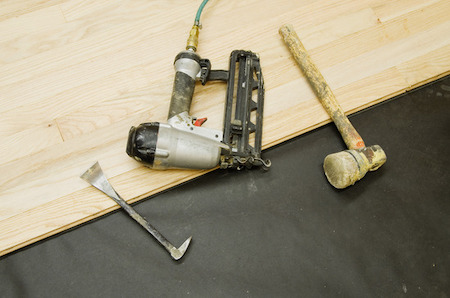 And the flooring is one of the prime examples where this process comes to light.
And the flooring is one of the prime examples where this process comes to light.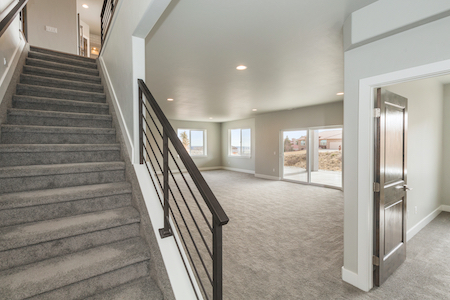 With windows in place, ensure that they aren’t covered and are fully used to give off natural light to the space throughout the day. Make them light, bright and airy by keeping the glass as clean as can be. If you do add curtains or blinds, be sure you can pull them away from the window during the day. Amplify this natural light as much as you can because it will improve the way your basement looks and functions.
With windows in place, ensure that they aren’t covered and are fully used to give off natural light to the space throughout the day. Make them light, bright and airy by keeping the glass as clean as can be. If you do add curtains or blinds, be sure you can pull them away from the window during the day. Amplify this natural light as much as you can because it will improve the way your basement looks and functions.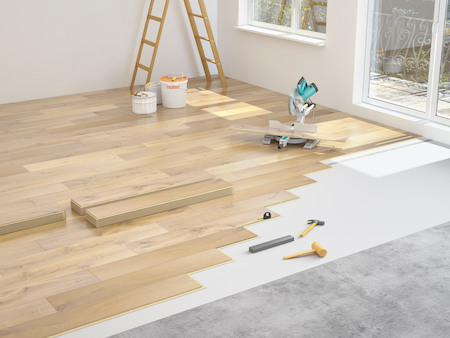 When you visit with an independent flooring retailer, you’ll talk with someone who has a wealth of knowledge ready and waiting for you. Flooring is all they do, and they do it well. They know all of the products on the marketplace, how easy they are to install, and how they wear over time. Because many independent flooring retailers have been in business for years, they also understand trends, and what flooring will stand the test of time. You can benefit from all of this expertise and more, and be able to get all of your questions answered easily. Try that with part-time help at a big box store, whose only goal is to make it to the weekend.
When you visit with an independent flooring retailer, you’ll talk with someone who has a wealth of knowledge ready and waiting for you. Flooring is all they do, and they do it well. They know all of the products on the marketplace, how easy they are to install, and how they wear over time. Because many independent flooring retailers have been in business for years, they also understand trends, and what flooring will stand the test of time. You can benefit from all of this expertise and more, and be able to get all of your questions answered easily. Try that with part-time help at a big box store, whose only goal is to make it to the weekend.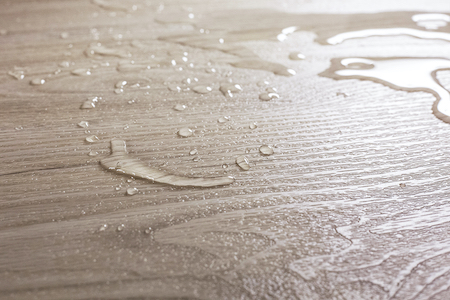 SPC – stone plastic composite – SPC has a rigid core that is virtually indestructible. It’s known for being 100 percent waterproof, and uses engineered technology to replicate both hardwood and stone tiles. Vinyl may have some give, has a flexible core. WPC does a pretty good job of firming it up and making it stand up well under pressure. SPC’s core is rigid – think concrete – and will stand up to whatever pressure you give it.
SPC – stone plastic composite – SPC has a rigid core that is virtually indestructible. It’s known for being 100 percent waterproof, and uses engineered technology to replicate both hardwood and stone tiles. Vinyl may have some give, has a flexible core. WPC does a pretty good job of firming it up and making it stand up well under pressure. SPC’s core is rigid – think concrete – and will stand up to whatever pressure you give it.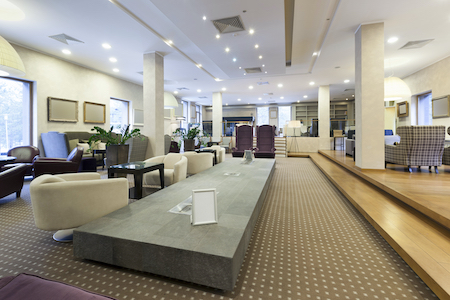 If you head up several floors, or to the back of the building, traffic drops off considerably. That doesn’t mean you want to lower the quality. You still want a cohesive look throughout.
If you head up several floors, or to the back of the building, traffic drops off considerably. That doesn’t mean you want to lower the quality. You still want a cohesive look throughout.